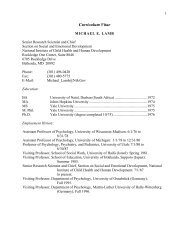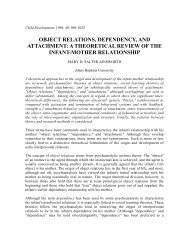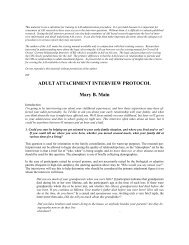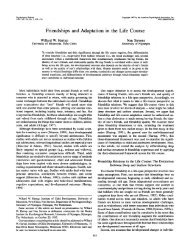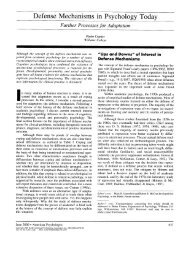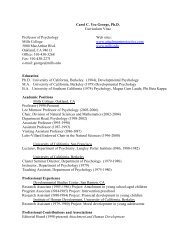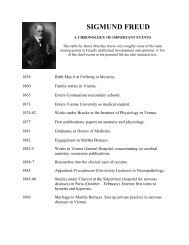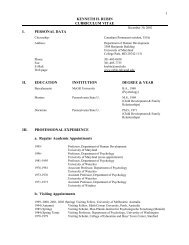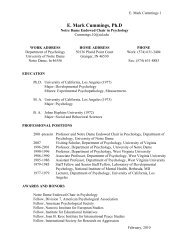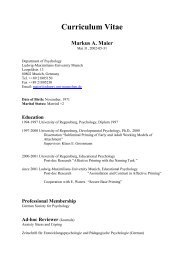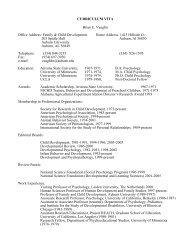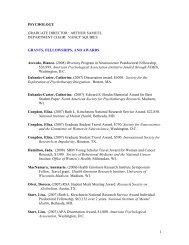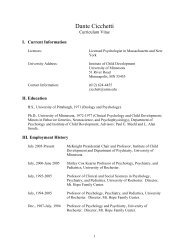Mario Mikulincer - Psychology Department @ SUNY Stony Brook
Mario Mikulincer - Psychology Department @ SUNY Stony Brook
Mario Mikulincer - Psychology Department @ SUNY Stony Brook
You also want an ePaper? Increase the reach of your titles
YUMPU automatically turns print PDFs into web optimized ePapers that Google loves.
<strong>Mikulincer</strong>, M., & Arad, D. (1999). Attachment working models and cognitive<br />
openness in close relationships: A test of chronic and temporary accessibility<br />
effects. Journal of Personality and Social <strong>Psychology</strong>, 77, 710-725.<br />
<strong>Mikulincer</strong>, M. & Florian, V. (1999). The association between spouses’ self-reports of<br />
attachment styles and representations of family dynamics. Family Process, 38, 69-<br />
83.<br />
<strong>Mikulincer</strong>, M., & Florian, V. (1999). The association between parental reports of<br />
attachment style and family dynamics and offspring’s reports of adult attachment<br />
style. Family Process, 38, 243-257.<br />
<strong>Mikulincer</strong>, M., & Florian, V. (1999). Maternal-fetal bonding, coping strategies, and<br />
mental health during pregnancy – The contribution of attachment style. Journal of<br />
Social and Clinical <strong>Psychology</strong>, 18, 255-276.<br />
<strong>Mikulincer</strong>, M., & Horesh, N. (1999). Adult attachment style and the perception of<br />
others – The role of projective mechanisms. Journal of Personality and Social<br />
<strong>Psychology</strong>, 76, 1022-1034.<br />
<strong>Mikulincer</strong>, M., Horesh, N., Eilati, I., & Kotler, M. (1999). The association between<br />
adult attachment style and mental health in extreme life endangering conditions.<br />
Personality and Individual Differences, 27, 831-842.<br />
Orbach, I., <strong>Mikulincer</strong>, M., Blumenson, R., Mester, R., & Stein, D. (1999). The<br />
subjective experience of problem irresolvability and suicidal behavior: Dynamics<br />
and measurement. Suicide and Life Threatening Behavior, 29, 150-164.<br />
Taubman Ben-Ari, O., Florian, V., & <strong>Mikulincer</strong>, M. (1999). The impact of mortality<br />
salience on reckless driving – A test of terror management mechanisms. Journal of<br />
Personality and Social <strong>Psychology</strong>, 76, 35-45.<br />
Florian, V., <strong>Mikulincer</strong>, M., & Hirschberger, G. (2000). The anatomy of a problematic<br />
emotion – The conceptualization and measurement of the experience of pity.<br />
Imagination, Cognition, and Personality, 19, 3-26.<br />
<strong>Mikulincer</strong>, M., Birnbaum, G., Woddis, D., & Nachmias, O. (2000). Stress and<br />
accessibility of proximity-related thoughts: Exploring the normative and<br />
intraindividual components of attachment theory. Journal of Personality and Social<br />
<strong>Psychology</strong>, 78, 509-523.<br />
<strong>Mikulincer</strong>, M., & Florian, V. (2000). Exploring individual differences in reactions to<br />
mortality salience – Does attachment style regulate terror management<br />
mechanisms? Journal of Personality and Social <strong>Psychology</strong>, 79, 260-273.<br />
<strong>Mikulincer</strong>, M., & Sheffi, E. (2000). Adult attachment style and cognitive reactions to<br />
positive affect: A test of mental categorization and creative problem solving.<br />
Motivation and Emotion, 24, 149-174.<br />
Taubman Ben-Ari, O., Florian, V., & <strong>Mikulincer</strong>, M. (2000). Does a threat appeal<br />
moderate reckless driving? – A terror management theory perspective. Accident<br />
Analysis and Prevention, 32, 1-10.



